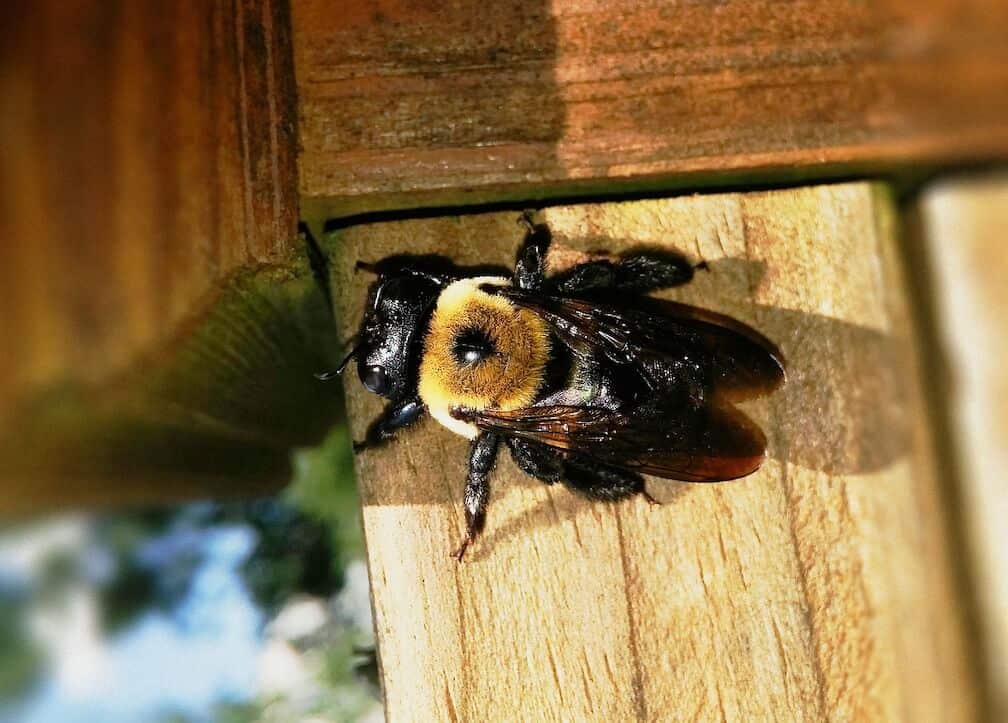Carpenter bees are some of the largest native bees in the U.S. They resemble the bumblebee and are often confused for them, but there are several differences. Carpenter bees have a shiny, black abdomen rather than the yellow and black striped abdomen of the bumblebee. Also, the thorax on the carpenter bee is covered with yellow, white, or orange hair which is not the case in a bumblebee.
Our goal for this blog is to help answer the common questions we get about Carpenter bees:
- Where do carpenter bees live?
- Do carpenter bees eat wood?
- What is the carpenter bee's life cycle?
- Are carpenter bees dangerous?
- What are the benefits of carpenter bees?
- What are the signs of carpenter bees?
- How do I prevent carpenter bees?
Where Do Carpenter Bees Live?
Carpenter bees are known to inhabit every continent except Antarctica, and there are approximately 500 species. They tend to live alone, but sometimes mother and daughter pairs may share a nest. Often several bees will build nests close together. This is unusual since most bees build hives where large numbers of bees reside. The carpenter bee is aptly named since it truly is a "carpenter." With its sharp jaws, a carpenter bee will tunnel into the wood of a tree, deck, beam, porch rail, or anything else made of wood.
Do Carpenter Bees Eat Wood?
Carpenter bees do not eat wood, as a termite does. They eat pollen and nectar and are only burrowing into the wood to create a nest. If you have round half-inch holes in your wooden structures, this is a good indication that you have carpenter bees.
What is a Carpenter Bee’s Life Cycle?
Like other bees, these bees hibernate during the cold winter months and emerge during the spring. After mating, the male dies and the female expands her nest to make room for her babies. She creates new "brood cells," fills them with regurgitated pollen and nectar, then lays eggs in each new compartment. It only takes a few days for these eggs to hatch, but they will not reach adulthood for about six weeks.
Are Carpenter Bees Dangerous?
The answer to this question is yes, and no. These bees are not typically dangerous to humans. The males have no stingers, and the females will only sting if they are brought into direct contact with the skin or they feel threatened. If a female does sting, the effects are similar to any bee sting which can be extremely painful; and if the person stung is allergic, the effects can include burning, itching, body swelling and rash, weakness, nausea, difficulty breathing, shock or unconsciousness.
In addition, carpenter bees are directly dangerous to unprotected wooden structures. Since they tunnel into wood, they can weaken beams or walls. There is also the danger that woodpeckers may forage into the tunnels creating more damage. In addition, wood-decaying types of fungi or invasion of other insects can cause more structural damage.
What are the Benefits of Carpenter Bees?
Carpenter bees are excellent pollinators. They are particularly helpful in pollinating farm crops such as tomato, eggplant, and other vegetables. They prefer to work in the morning and can be found collecting nectar on crop and ornamental plants during this time. They are known as “buzz pollinators,” which means that they actually become like little tuning forks and apply sound energy to loosen particles of pollen from within the plant. This process is referred to as "sonication". These bees are also able to use their mouthparts to ‘slice’ the bottoms of the corolla in long, tubular flowers in order to steal away the pollen that they would otherwise not be able to reach because of their large size. Ingenious little creatures, really!
Signs of Carpenter Bees
- Holes in wood structures that are about 1/2 in diameter
- Sawdust piles from hole creation
- Large, slow-moving bees buzzing around a wooden structure
- A bee standing guard near the gallery hole
How To Prevent Carpenter Bees?
- Apply paint or stain to your wood structures. Even a clear stain is enough to seal the wood so that the female carpenter bee is not able to carve a gallery.
- Treat any old holes with wood filler and then refinish the wood so that no more carpenter bees can continue to carve in galleries that have already been started.
If you are concerned about carpenter bees damaging your property, the best course of action is to employ the help of a professional pest control company. Here at Rottler Pest Solutions, we have decades of experience in all aspects of the problems associated with pests – inside and outside of homes.
Don't take chances with carpenter bees, or any other pest, call for your FREE pest inspection today.


